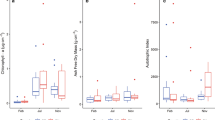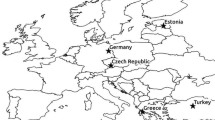Abstract
Factors related to autochthonous production were investigated at several sites along a prairie stream at Konza Prairie Research Natural Area. Primary production, algal biomass, litter input, and ability of floods to move native substrate were measured. Additional experiments were conducted to establish the influence of light and water velocity on primary production rates and recovery of biomass following dry periods. The study period encompassed two extreme (> 50 year calculated return time) floods, thus we were able to analyze the effects of scour on periphyton biomass and productivity. Biomass of sedimentary algae was reduced greatly by flooding and did not reach preflood amounts during the 2 months following the first flood. Rates of primary production associated with sediments recovered to levels above preflood rates within 2 weeks. Biomass of epilithic periphyton was not affected as severely as that of sedimentary algae. Little relationship was observed between water velocity and photosythetic rates. Production reached maximum rates at 25% of full sun light. Epilithic chlorophyll levels recovered within eight days following a dry period, and chl a was an order of magnitude greater on rocks than sediments 51 days after re-wetting. Estimated annual rates of primary production were 2.6 times greater in the prairie than in the forest reaches of the stream. The ratio of annual autochthonous:allochthonous carbon input was 4.81 for prairie and 0.32 for the forest. Periphyton production in prairie streams is resilient with regard to flooding and drought and represents a primary carbon source for the system.
Similar content being viewed by others
References
APHA, 1989. Standard Methods for the Examination of Water and Wastewater, 17th edn. American Public Health Association, Washington D.C.
Busch, D. E. & S. C. Fisher, 1981. Metabolism of a desert stream. Freshwat. Biol. 11: 301–307.
Clement, R. W., 1987. Floods in Kansas and techniques for estimating their magnitude and frequency on unregulated streams. United States Geological Survey, Water-Resources Investigations Report 87–4008, 50 pp.
Dodds, W. K., 1991. Community interactions between the filamentous alga Cladophora glomerata (L.) Keutzing, its epiphytes and epiphyte grazers. Oecologia 85: 572–580.
Dodds, W. K. & D. A. Gudder, 1992. The ecology of Cladophora. J. Phycol. 28: 415–427.
Fisher, S. G., L. J. Gray, N. B. Grimm & D. E. Busch, 1982. Temporal succession in a desert stream ecosystem following flash flooding. Ecol. Monogr. 52: 93–110.
Fisher, S. G. & N. B. Grimm, 1988. Disturbance as a determinant of structure in a Sonoran Desert stream ecosystem. Verh. Int. Ver. Theor. Angewandte Limnol. 23: 1183–1189.
Fisher, S. G. & G. E. Likens, 1973. Energy flow in Bear Brook, New Hampshire: An integrative approach to stream metabolism. Ecol. Mongr. 43: 421–439.
Gelroth, J. V. & G. R. Marzolf, 1978. Primary production and leaflitter decomposition in natural and channelized portions of a Kansas stream. Am. Midl. Nat. 99: 238–243.
Gurtz, M. E. & C. M. Tate, 1988. Hydrologic influences on leaf decomposition in a channel and adjacent bank of a gallery forest stream. Am. Midl. Nat. 120: 11–21.
Gurtz, M. E., G. R. Marzolf, K. T. Killingbeck, D. L. Smith & J. V. McArthur, 1988. Hydrologic and riparian influences on the import and storage of coarse particulate organic matter in a prairie stream. Can. J. Fish. aquat. Sci. 45: 655–665.
Hooker, K. L., 1987. Factors affecting the nitrate removal potential of sediments from a tallgrass prairie stream. PhD dissertation, Kansas State University, Manhattan, KS, 107 pp.
Knight, C. L., J. M. Briggs & M. D. Nellis, 1994. Expansion of gallery forest on Konza Prairie Research Natural Area, Kansas, USA. Landscape Ecol. 9: 117–125.
LaBarbera, M. & S. Vogel, 1976. An inexpensive thermistor flow meter for aquatic biology. Limnol. Oceanogr. 21: 750–756.
Lohman, K. J., J. R. Jones & B. D. Perkins, 1992. Effects of nutrient enrichment and flood frequency on periphyton biomass in northern Ozark streams. Can. J. Fish. aquat. Sci. 49: 1198–1205.
Matthews, W. J., 1988. North American prairie streams as systems for ecological study. J. No. Am. Benthol. Soc. 7: 387–409.
McBrayer, J. F. & K. Cromack, Jr., 1980. Effect of snow pack on lake-litter breakdown and nutrient release in a Minnesota forest. Pedobiologia 20: 47–54.
Peterson, C. G. & R. J. Stevenson, 1990. Post-spate development of epilithic algal communities in different current environments. Can. J. Bot. 68: 2092–2102.
Peterson, C. G. & R. J. Stevenson, 1992. Resistance and resilience of lotic algal communities: importance of disturbance timing and current. Ecology 73: 1445–1461.
Power, M. E. & A. J. Stewart, 1987. Disturbance and recovery of an algal assemblage following flooding in an Oklahoma stream. Am. Midl. Nat. 117: 333–345.
Tate, C. M. & M. E. Gurtz, 1986. Comparison of mass loss, nutrients, and invertebrates associated with elm leaf litter decomposition in perennial and intermittent reaches of tallgrass prairie streams. Southwest. Nat. 31: 511–520.
Tate, C. M., 1990. Patterns and controls of nitrogen in tallgrass prairie streams. Ecology 71: 2007–2018.
Wetzel, R. G. & G. E. Likens, 1991. Limnological Analysis, 2nd edition. Springer-Verlag, New York.
Whittaker, R. H., 1975. Communities and Ecosystems, 2nd edition. Macmillan Publishing Co., New York.
Author information
Authors and Affiliations
Rights and permissions
About this article
Cite this article
Dodds, W.K., Hutson, R.E., Eichem, A.C. et al. The relationship of floods, drying, flow and light to primary production and producer biomass in a prairie stream. Hydrobiologia 333, 151–159 (1996). https://doi.org/10.1007/BF00013429
Received:
Revised:
Accepted:
Issue Date:
DOI: https://doi.org/10.1007/BF00013429




